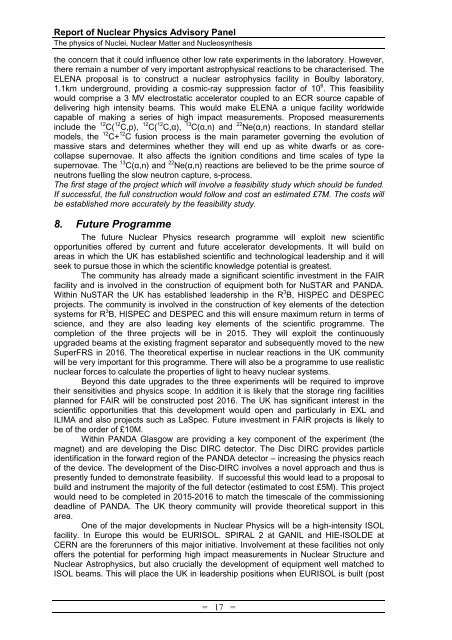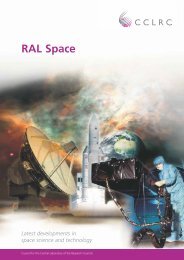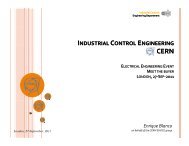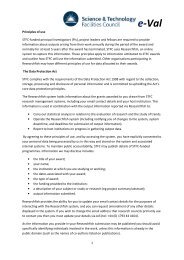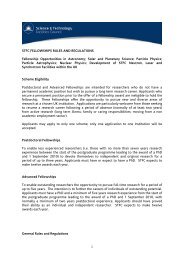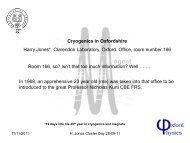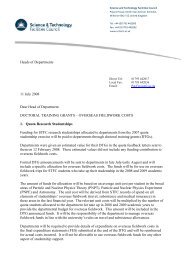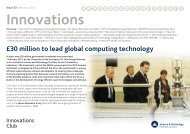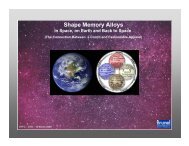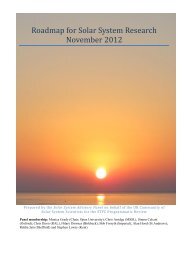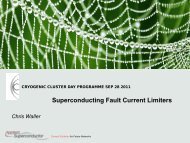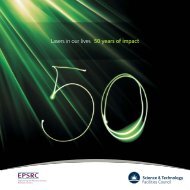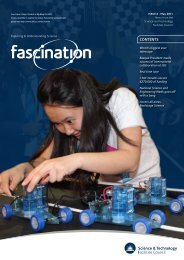Nuclear Physics Advisory Panel (NPAP) report (PDF-3.8 MB) - STFC
Nuclear Physics Advisory Panel (NPAP) report (PDF-3.8 MB) - STFC
Nuclear Physics Advisory Panel (NPAP) report (PDF-3.8 MB) - STFC
Create successful ePaper yourself
Turn your PDF publications into a flip-book with our unique Google optimized e-Paper software.
Report of <strong>Nuclear</strong> <strong>Physics</strong> <strong>Advisory</strong> <strong>Panel</strong><br />
The physics of Nuclei, <strong>Nuclear</strong> Matter and Nucleosynthesis<br />
the concern that it could influence other low rate experiments in the laboratory. However,<br />
there remain a number of very important astrophysical reactions to be characterised. The<br />
ELENA proposal is to construct a nuclear astrophysics facility in Boulby laboratory,<br />
1.1km underground, providing a cosmic-ray suppression factor of 10 6 . This feasibility<br />
would comprise a 3 MV electrostatic accelerator coupled to an ECR source capable of<br />
delivering high intensity beams. This would make ELENA a unique facility worldwide<br />
capable of making a series of high impact measurements. Proposed measurements<br />
include the 12 C( 12 C,p), 12 C( 12 C,α), 13 C(α,n) and 22 Ne(α,n) reactions. In standard stellar<br />
models, the 12 C+ 12 C fusion process is the main parameter governing the evolution of<br />
massive stars and determines whether they will end up as white dwarfs or as corecollapse<br />
supernovae. It also affects the ignition conditions and time scales of type Ia<br />
supernovae. The 13 C(α,n) and 22 Ne(α,n) reactions are believed to be the prime source of<br />
neutrons fuelling the slow neutron capture, s-process.<br />
The first stage of the project which will involve a feasibility study which should be funded.<br />
If successful, the full construction would follow and cost an estimated £7M. The costs will<br />
be established more accurately by the feasibility study.<br />
8. Future Programme<br />
The future <strong>Nuclear</strong> <strong>Physics</strong> research programme will exploit new scientific<br />
opportunities offered by current and future accelerator developments. It will build on<br />
areas in which the UK has established scientific and technological leadership and it will<br />
seek to pursue those in which the scientific knowledge potential is greatest.<br />
The community has already made a significant scientific investment in the FAIR<br />
facility and is involved in the construction of equipment both for NuSTAR and PANDA.<br />
Within NuSTAR the UK has established leadership in the R 3 B, HISPEC and DESPEC<br />
projects. The community is involved in the construction of key elements of the detection<br />
systems for R 3 B, HISPEC and DESPEC and this will ensure maximum return in terms of<br />
science, and they are also leading key elements of the scientific programme. The<br />
completion of the three projects will be in 2015. They will exploit the continuously<br />
upgraded beams at the existing fragment separator and subsequently moved to the new<br />
SuperFRS in 2016. The theoretical expertise in nuclear reactions in the UK community<br />
will be very important for this programme. There will also be a programme to use realistic<br />
nuclear forces to calculate the properties of light to heavy nuclear systems.<br />
Beyond this date upgrades to the three experiments will be required to improve<br />
their sensitivities and physics scope. In addition it is likely that the storage ring facilities<br />
planned for FAIR will be constructed post 2016. The UK has significant interest in the<br />
scientific opportunities that this development would open and particularly in EXL and<br />
ILIMA and also projects such as LaSpec. Future investment in FAIR projects is likely to<br />
be of the order of £10M.<br />
Within PANDA Glasgow are providing a key component of the experiment (the<br />
magnet) and are developing the Disc DIRC detector. The Disc DIRC provides particle<br />
identification in the forward region of the PANDA detector – increasing the physics reach<br />
of the device. The development of the Disc-DIRC involves a novel approach and thus is<br />
presently funded to demonstrate feasibility. If successful this would lead to a proposal to<br />
build and instrument the majority of the full detector (estimated to cost £5M). This project<br />
would need to be completed in 2015-2016 to match the timescale of the commissioning<br />
deadline of PANDA. The UK theory community will provide theoretical support in this<br />
area.<br />
One of the major developments in <strong>Nuclear</strong> <strong>Physics</strong> will be a high-intensity ISOL<br />
facility. In Europe this would be EURISOL. SPIRAL 2 at GANIL and HIE-ISOLDE at<br />
CERN are the forerunners of this major initiative. Involvement at these facilities not only<br />
offers the potential for performing high impact measurements in <strong>Nuclear</strong> Structure and<br />
<strong>Nuclear</strong> Astrophysics, but also crucially the development of equipment well matched to<br />
ISOL beams. This will place the UK in leadership positions when EURISOL is built (post<br />
= 17 =


